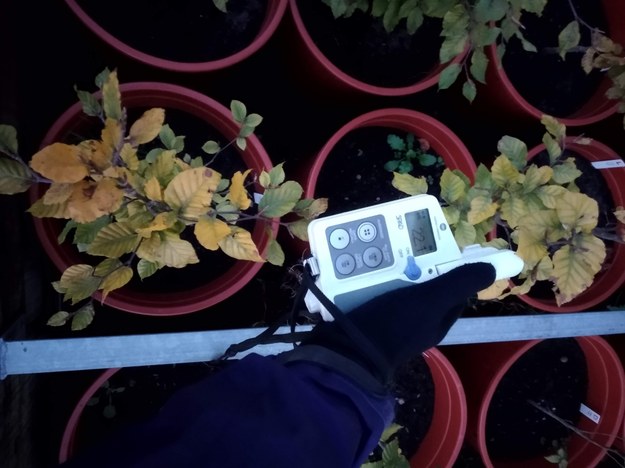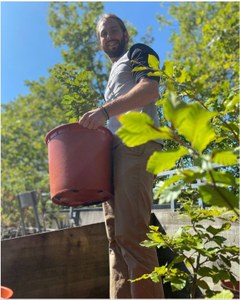Fresh graduate Daniel Palouš co-authored an article in the journal Science
Daniel Palouš completed his master's studies at the Department of Experimental Plant Biology with his diploma thesis under the supervision of prof. Albrechtová and with the consultation of the team members of the Laboratory of Plant Ecophysiology - Dr. Zuzana Lhotáková and Dr. Eva Neuwirthová and also Dr. Pavel Bednář from VÚLHM. During work on his master's degree in Experimental Plant Biology with specialization in Plant Ecophysiology in the years 2020-2023 at the Faculty of Science, Charles University, Daniel decided to spend the winter semester in 2021 at the renowned institution ETH Zurich in Switzerland, in a laboratory working on research compatible with the topic of his Master thesis, which was: "Evaluation of the physiological status of European beech in its plantings on localities following the gradient of its ecological valence".
The choice fell to the prestigious laboratory of Prof. Dr. Tom Crowther (crowtherlab.com). Daniel worked on a project of his diploma thesis in the Laboratory of Plant Ecophysiology, which is headed by prof. Jana Albrechtová, precisely under her supervision and with the consultation of other members of the laboratory - Dr. Zuzana Lhotáková and Dr. Eva Neuwirthová. Another consultant was Dr. Pavel Bednář from the Forestry and Game Management Research Institute (VÚLHM), who recommended research sites for terrain campaign with various beech plantings, suitable for diploma thesis research questions. Since there’s no agreement between the Faculty of Science, Charles University and ETH, Daniel contacted Tom Crowther's laboratory directly with great help of Jana Albrechtová. Daniel also approached a number of university funds and other foundations to obtain financial support for a research internship. Daniel was very successful in gaining support and filled the internship at ETH Zurich with full involvement in the research work of Tom Crowther's team. Daniel contributed by taking measurements monitoring the process of autumn leaf senescence in European beech seedlings (Fagus sylvatica) followed by a statistical analysis of acquired data, which was the experimental part of the mentioned study, for which he was invited as a co-author. The output is the co-authorship of a study recently published in the prestigious journal Science.
 Measurement of relative chlorophyll content in leaves with SPAD 502 - Plus, Konica Minolta, on beech seedlings.
Measurement of relative chlorophyll content in leaves with SPAD 502 - Plus, Konica Minolta, on beech seedlings.
Daniel Palouš says: "I am delighted about this success and that I can share it with the team of The Laboratory of Plant Ecophysiology under the leadership of J. Albrechtová, who sent me for an internship at ETH and gave me a solid foundation for a full-fledged involvement in research there. Professor Jana Albrechtová and Dr. Zuzana Lhotáková very willingly helped me with the preparation of the internship and provided me with letters of recommendation for various foundations that I approached for financing the internship. I see this support as extraordinary and I appreciate it very much. It is also my pleasure to represent the entire Department of Experimental Plant Biology of the Faculty of Science, Charles University. And of course, I am very grateful for the kind and very efficient reception in Tom Crowther's laboratory and the support of all its members in carrying out my research during the internship. Last but not least I’d like to thank all the foundations that provided me with sufficient funds and allowed me to fully focus on my studies." Thanks to the internship, where he learned the basics of modeling, Daniel was able to include in his diploma thesis a chapter of results focused on a model of the dependence of budburst timing on the average air temperature in a certain period before budburst itself. Daniel Palouš successfully defended his diploma thesis in January 2023.
Financial support for Daniel Palouš to cover the costs of the internship including tuition fees at ETH was provided by: The Foundation Fund of the Faculty of Science of Charles University, The Mobility Fund of the Charles University, The Support for Internationalization of the Charles University, The Hlávka Foundation and The Foundation for the Development of Education.

The summer solstice effect on the vegetation season length
Spring keeps getting earlier, but the timing of leaf fall in autumn has been more of a mystery. For the first time, a study helps solve this mystery by revealing the pivotal role of the summer solstice. The research shows that warming before the solstice triggers an earlier onset of leaf senescence, while warming after the solstice slows down the discoloration process.
Forests have long been recognized as crucial carbon sinks. However, in temperate and boreal regions, the ability of trees to draw down carbon is constrained by an annual winter pause. Understanding when the growing season will end under a warming climate is therefore paramount for accurately modelling global carbon cycles.
A new publication in the journal Science sheds light on the complex interplay of environmental factors that affect the timing of autumn leaf senescence in northern forests during which leaves start to lose their green colour and finally fall off the trees. Using diverse data sources, including experiments, ground observations, carbon flux measurements, and satellite data, the scientists discovered that a warmer climate during the growing season is a key driver for autumn onset. Their analyses reveal that the effects of climate warming on this phenological process are contingent upon whether it occurs before or after the summer solstice, a key astronomical event that typically falls on 21 June in the northern hemisphere.
Specifically, when warming takes place before the summer solstice, autumn starts earlier due to accelerated seasonal cycles in trees, resulting in the onset of leaf senescence and declining photosynthesis. Conversely, warming after the summer solstice slows the progression of leaf senescence, extending the duration of autumn and causing leaves to fall later. On average, each degree Celsius of presolstice warming advances the onset of leaf senescence by 1.9 days, while each degree Celsius of postsolstice warming extends the senescence process by 2.6 days.
But why do the effects switch around the summer solstice? “The unique shift in effects around the summer solstice is understood as an evolutionary adaptation that allows trees to synchronise their growth rhythms with the changing day length”, says Dr. Constantin Zohner, the lead author of the paper.
This is the first time a study was able to detect both effects at the same time. The findings hold true across continents and forest types, providing a unified understanding of the constraints and drivers of the growing season. “Understanding the timing of autumn leaf senescence for temperate and boreal trees is critical to our efforts to predict landscape changes, carbon storage capacity, and the overall impact of climate change on forest ecosystems”, concludes Prof. Dr. Thomas Crowther, senior author of the paper.
Zohner, Constantin & Mirzagholi, Leila & Mo, Lidong & Bucher, Raymo & Palouš, Daniel & Vitasse, Yann & Fu, Yongshuo & Stocker, Benjamin & Crowther, Thomas. (2022). Effect of climate warming on the timing of autumn leaf senescence reverses at the summer solstice. 10.21203/rs.3.rs-1336514/v1.
Document Actions